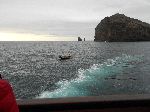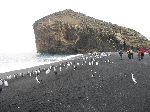 |
AZPawlowski.com |
|
 |
|
|
| |
Photo Galleries Home
Gallery: 9-Landings in Antarctica-Deception Island (200)
Event Code: 12182011 |
(December 18th, 2011)L’AUSTRAL Daily Journal-December 18th, 2011 – South Shetland Islands.
Andrew Wenzel.
At 05:00 this morning, L’Austral arrived at Deception Island. The volcanic island is dark and foreboding as much of the landscape is covered in volcanic ash from previous eruptions, the
last of which was in 1971.
Nicolas, our Expedition Leader, had a lot planned for us today. We were starting our day with a pre-breakfast landing at one of the largest Chinstrap Penguin colonies in all of Antarctica. An incredible 160, 000 pairs of penguins nest here every summer. The plan was for the fit and hardy to hike from the black sandy beaches of Baily Head, proceed around
the colony and continue on to the inner flooded caldera of the island where they would rendezvous with the ship.
For those who elected to not participate in the hike, there were several options.
Option 1: land at Baily head, visit the colony and then return to the ship.
Option 2: tour the impressive landscape around Baily Head by zodiac and then return to
L’Austral.
Option 3: stay in bed! – and then scenic cruise on L’Austral through the dramatic narrow
entrance of the flooded caldera called Neptune’s Bellows and proceed to the rendezvous in
Whalers’ Bay.
In order to have the optimum conditions to land at Baily Head and to accomplish everything
we had in store for the day, an early morning start was essential. Blearily, we wiped the
sleep from our eyes and stumbled into the lounge on deck three, where there was lots of
fresh fruit, pastries and coffee waiting for us.
Baily Head is notorious for challenging landings in heavy surf. Today Neptune treated us
favourably with a light surf... well, it was light for Baily Head but it was still a challenge to
get everyone safely on the beach. It took a team of no less than six to secure the zodiac on
the beach. Four hardy sailors dressed in dry suits and two members of Expedition Team.
Soon enough everyone was safely on the beach and the hikers set off. Meanwhile for those
that opted for the zodiac cruise only, two Humpback Whales were seen very close to the
ship. What a stroke of great luck for those people in the zodiacs!
As we crested the first small hill overlooking the Chinstrap colony the full impact of
hundreds of thousands of penguins hit us in the face. The noise of the ecstatic displays was
a wall of sound. Chinstrap nests lined the hillsides of a giant amphitheatre of penguins. It
was impressive.
There was lots of room to walk around the nesting sites, down across the bowl and up the
other side. After about thirty minutes the colony was behind us. We continued our uphill
climb over icy snow fields until we reached an excellent viewpoint for a group photo at
approximately the half way point. Well... it would have been an excellent viewpoint but the
weather had begun to close in. A driving snow ripped across the hill-tops and soon our view
was lost in a white haze. The good news was that the wind and snow was from behind us.
A little push in the back from the wind was not unwelcome.
The descent into Whalers’ Bay was steep and icy at times but after 2.50 hours we arrived on
the lava plain below Neptune’s Window. Neptune’s Window is a large break high up on the
caldera wall from which it is possible to see the continent on a clear day.
Shortly before 09:00 all of the hikers were back on board L’Austral, feeling proud of their
accomplishment. The number of people in the world that have made this hike comprises a
very small club. We did more before 9 am than most people do all day!!
Our second landing of the day was deep inside the caldera at Telefon Bay where we dropped
anchor at approximately 09:45. A second hike was offered here, albeit a much shorter hike.
Going straight up from the beach we walked up a gentle slope to the rim of a crater. At the
bottom of the crater was a small lake. The view was inspiring. An alternative route back
was possible down through a small valley.
In the afternoon we made way for our third and final landing of our great adventure in
Antarctica. En route at approximately 15:00, we encountered three Humpback Whales.
One of the whales was thrashing his mighty flukes on the surface of the water, a behaviour
called lob-tailing. We could see large white scars on one of the whales which undoubtedly
were caused by an encounter with a boat’s propeller a long time ago. After about thirty
minutes, we bid adieu to the whales and continued on our course to Aitcho Islands.
At 17:00 we dropped anchor. Soon the first zodiacs were whisking people to the beach.
This was our final stop in Antarctica and it was to be one of the most memorable landings of
all. Gentoo and Chinstrap Penguins lined the beach. Near the landing site were nesting
Gentoos and a little higher up the slope were nesting Chinstraps. While the two species will
nest in the same general area, the colonies are always segregated. There are Chinstrap
neighbourhoods and there are Gentoo neighbourhoods.
We were led on a twenty minute hike that rambled over the rolling landscape of Aitcho. We
eventually encountered a stream which led us up a gentle slope. We had been instructed to
walk in the stream. In that manner we were able to avoid treading on the sensitive green
moss. At the top of the hill we were rewarded with a dramatic rugged vista. Below us we
could see a large volcanic plug near a wild beach. At the base of the rocky plug were
approximately twenty female Southern Elephant Seals lying peacefully in a wallow. A little
further there were another thirty young male Elephant seals in two different wallows above
the beach. A lone Weddell Seal lay on the ice which covered part of a small fresh water
pond. Skuas seemed to be everywhere. There were at least 25 Skuas in the area by the
Elephant Seals alone.
A light rain fell throughout most of the landing but by now we were all prepared for just
about any weather eventuality.
At 20:00 everyone was back on the ship. Shortly after, we lifted the anchor. The Captain
welcomed us back to the ship and over the public address system informed us that we
would use English Passage as our entrance to the Drake Passage. We were also all pleased
to hear that the weather forecast for the Drake Passage was favourable.
|
Displaying Gallery Page 1 of 23
1 2 3 4 5 6 7 8 9 10 11 12 13 14 15 16 17 18 19 20 21 22 23 |

|

|

|

|

|

|

|

|

|
|
| |
|
ec2-18-221-98-71.us-east-2.compute.amazonaws.com
Tuesday, April 30, 2024 9:02:34 AM
Copyright © 1998-2024, Andy Pawlowski, All rights reserved.
AZPawlowski.com - Carson City, NV. |
|
